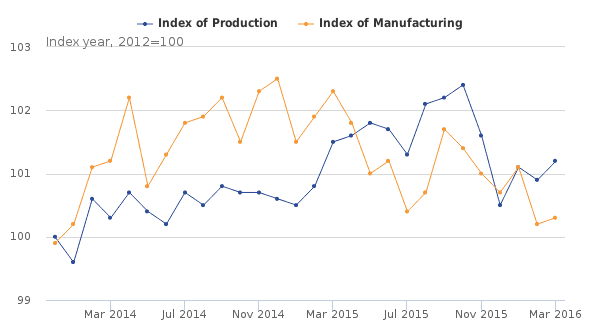Pound Sterling Weighed Down by Poor Industrial + Manufacturing Production Data

Another day, another disappointing set of economic data from the United Kingdom.
- Pound falls against euro, dollar at 07:30 UK time, ahead of poor UK data release
- GBP under pressure as traders reduce exposure to currency ahead of Bank of England's Super Thursday event
- "Sterling’s recent depreciation and our expectations that global growth will pick up slightly in 2016 should allow the sector to return to modest growth later this year." - Capital Economics.
The British pound is week in mid-week trade having fallen notably against the euro and US dollar while giving up some of the gains it recorded against the commodity currency bloc.
The pound started its decline against the euro at about 7:30 London time and was therefore already weak walking into a poor set of industrial production statistics.
There is a chance that a big trader opted to clear exposure on sterling in the run up to the Bank of England’s Inflation Report due on Thursday, we would expect GBP to remain subdued into this key risk event.
Any hopes of a rebound on the back of a positive data surprise were ultimately dashed when it was reported UK Manufacturing Production fell to 0.1% in the month to March undershot economist forecasts for a reading of 0.3%.
The data was however a great deal better than the previous month’s reading of -0.9% which was upgraded.
Industrial Production data read at 0.3%, worse than the 0.5% expected.

Sentiment towards the UK currency remains subdued this week, particularly after the release of trade data on Tuesday that confirms GBP remains exposed to a an ever-increasing current account deficit.
The British pound is likely to remain unloved heading into the Bank of England’s 'Super Thursday' event in which markets will ascertain whether the current run of soft statistics coming out of the UK economy are having an impact on interest rate decision making.
Downgrades to economic growth in the forecasts due to be released by the Bank in their Inflation Report are therefore a potential source of sterling weakness over the course of the coming 48 hours.
Economist Reactions to Disappointing Manufacturing and Industrial Production Data
- Ruth Miller, UK Economist at Capital Economics:
“Looking ahead, a further weakening in April’s Markit/CIPS manufacturing PMI suggests that the manufacturing sector started Q2 on a poor footing.
“While Brexit uncertainty may be partly to blame, the sector’s poor performance of late is certainly nothing new and many of the headwinds to growth in 2015 emanating from a weak global environment are still in place.
"Sterling’s recent depreciation and our expectations that global growth will pick up slightly in 2016 should allow the sector to return to modest growth later this year."
- Dennis de Jong at UFX.com:
“Although today’s results show a few signs of encouragement, we will likely have to wait until after next month’s EU referendum for the prospect of any serious growth in the sector.
“British manufacturing hasn’t been in the headlines for the right reasons in recent months, with the Tata Steel crisis and weakening global demand leaving very little to cheer.”
- Lloyds Bank:
“While the data show a modest pickup in manufacturing activity towards the end of Q1, the overall level is still low enough to suggest that it will probably make little contribution to GDP growth in Q1.
“The recent weakening in the sterling effective exchange is still consistent with some pick up in manufacturing output in coming months but it appears at least for now that GDP growth will remain overwhelmingly services driven. Moreover, given signs that service sector growth slowed during Q1, we expect only a modest rise in GDP in Q2 of 0.3%.”




